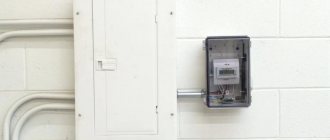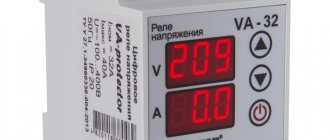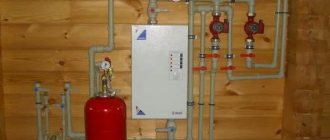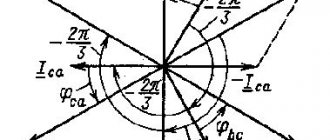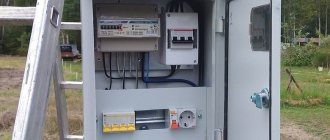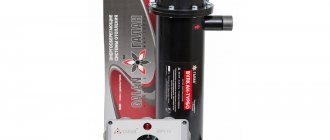Principle of operation
Uninterruptible power supplies for a private home
The principle of operation is that in the presence of an external power supply network, the inverter passes voltage to consumers, while the charger built into it recharges the battery. When the power supply goes out, the inverter instantly switches to operation from batteries and converts their direct voltage into alternating voltage.
According to their purpose, electricity storage devices are divided into 2 categories:
- uninterruptible power supply (UPS) to ensure the operation of household electrical appliances;
- uninterruptible power supply for the home in case of a power outage.
Products vary in composition, size, power, cost and discharge duration. They can be located both inside the building and outside it in separate buildings.
What else is important to consider?
To correctly select a battery, it is necessary to evaluate the total power of all energy consumers and the required operating time between recharges:
When you are calculating the energy capacity you will need to run autonomously, always add 20% as a safety factor. This is a good reserve in case of exceeding the quota and future battery degradation.
Don't forget about the charge controller and monitoring. Otherwise, you may arrive at your wonderful off-grid home in the mountains and find that the solar panels were covered with snow two months ago, and the batteries are completely discharged and are now candidates for replacement. Always leave a couple of percent of charge free to allow for an alarm.
How to choose a battery for your home
UPS for a dacha with a power of 0.8 kW
If turning off the lights becomes a constant occurrence, you should think about purchasing an electricity storage device for your home. A computer battery will not solve the problem, as it has a limited resource. We need devices that can ensure the normal functioning of people for several hours, or better yet, days. Such a technical helping hand will come in handy during large-scale accidents on the line.
The selection criteria are as follows
- complexity of installation and commissioning;
- cost of delivery and special services;
- resistance to changes in temperature and humidity;
- Efficiency in modern devices reaches 98%;
- service life - 5000-10000 m/h;
Uninterruptible power supply SVEN RT-500 - overload capacity (withstanding the load when starting the generator) - 200-300%;
- automatic start time - a good energy storage device for the home during a power outage begins the conversion process within 10 ms;
- ability to work at low loads;
- autonomy - a tank designed for a day of engine operation;
- current quality - high-quality energy storage devices produce current with a deviation from industrial values of no more than 2%;
- number of charge-discharge cycles - at least 500;
- power - based on consumers with a margin of 30%, but not less than 6 kW;
- noise produced - inverters operate silently.
Modern high-power electrical energy storage devices can provide a home with energy for 1-2 days. When the power supply is restored, there is no need to turn them off; everything happens automatically.
No. 1. Generator for a summer residence: petrol, diesel, gas
The simplest and most popular way to solve the problem of electricity on a plot of land is to use a fuel-fired electricity generator. Essentially, this is a miniature power plant that operates completely autonomously and converts the energy of fuel combustion into electricity. Gasoline and diesel, less often gas, are used as fuel. To produce 1 kW/hour of energy, on average, 0.25 to 0.5 liters of fuel will be required.
Generators are the easiest way to organize power supply at home: buy it, connect it and you can use it, just don’t forget to top up the fuel on time. This is the main advantage. The main disadvantage is the need to constantly buy fuel, and if the house is large and there are a lot of electrical appliances, then the costs will be significant. In addition, the generator itself also costs money, and the higher its power, the higher the price. But if you compare it with a windmill or solar panel, the generator will, of course, be cheaper.
When the generator is a backup source of energy, it is important that it not only starts up in a timely manner, but also turns off in a timely manner so that there is no collision between two counter flows of charged electrons. To avoid troubles, an algorithm for including a generator in a common system has long been developed
If there is no central power supply network, then it is recommended to use two generators: one is the main one, the second is a backup and comes into operation when the first one runs out of fuel. Alternating operation of two generators significantly increases the service life of each.
The fuel the generator runs on determines its power, durability, noise level, and operating costs.
Diesel generator for a summer residence
Diesel power generators are best suited for continuous operation. Long continuous operation is ensured by the presence of a water cooling system. Among its other advantages:
- high demand for strength. In terms of durability, a diesel generator outperforms a gasoline generator;
- among diesel engines there are much more powerful models than among gasoline engines, which makes it possible to use a similar energy source even to supply large country houses;
- diesel is a cheaper fuel compared to gasoline.
Among the disadvantages:
- price;
- high noise during operation, so it will be difficult to manage without a separate room with sound insulation and ventilation. A gasoline generator also has exhaust gases, but they are not as caustic. It is best to place the diesel generator at some distance from the house, but you will have to take care of a canopy and a locking system to protect the generator from theft;
- starting is possible at a temperature not lower than -5C, although diesel generators in a protective casing have now appeared, thanks to which the device can be placed outdoors and operated at any temperature.
Gasoline generator for a summer residence
A gasoline generator is better suited in cases where the site is used occasionally. It can also work as a backup power source when the site is connected to the public network. In a small dacha with a minimal set of electrical appliances, a gasoline generator performs best. The power of gas generators is usually no higher than 7-9 kW (but you can find models with 15 and even 20 kW), and they cannot work longer than 8 hours continuously - they get very hot.
Advantages:
- low cost of the generator compared to its diesel counterpart. The price, of course, depends on the power, but it is, on average, two times lower than for diesel models;
- mobility. Gasoline generators are lighter and more compact than diesel ones, so if necessary, they are easy to move around the site;
- noise level is lower than that of a diesel analogue;
- ability to work at low temperatures.
Minuses:
- low efficiency;
- high cost of gasoline.
The noise level from a diesel and gasoline generator depends on the type of housing and the speed at which the generator operates: a device with 1500 rpm will produce significantly lower noise than a similar power one with 3000 rpm, but it will also cost more .
Gas generator for a summer residence
Gas generators make it possible to obtain the cheapest energy, while their operating efficiency is the highest and the noise is minimal. The power can reach 24 kW, the generator can operate around the clock, and gas will be cheaper than gasoline and diesel fuel. It’s just that such devices have not yet become widespread, since they cost a lot, are complicated to operate and require connection to a gas pipeline, which is not available everywhere. However, some summer residents connect such generators to gas cylinders.
Large home battery
Large home battery
The large home battery, produced in Russia by Ekomotors, is an inexpensive and effective analogue to the Tesla PowerWall drive. The product is used for backup power supply to private houses, cottages, offices and other facilities that can be cut off from electricity at any time. It can also be installed in caravans, cabins and mobile canteens. The device stores energy at low rates at night. It has compact dimensions and can be mounted on the wall in a vertical or horizontal position.
Specifications:
- capacity - 7.8 kW/h;
- battery voltage - 24 V;
- power - 7.2 kW;
- dimensions - 1000×500×250 mm;
- weight - 100 kg;
- number of cycles - 7000.
The operation and status of the device is monitored using an Android tablet with the ability to display information on a PC or cell phone.
Download
- Theory and practice of using batteries. Types of batteries. The best thing you can read on the topic is • Selection and operation of batteries for autonomous and backup power supply. / Theory and practice - in detail in simple language, pdf, 6.97 MB, downloaded: 520 times./
- • Dasoyan, Novoderezhkin, Tomashevsky. Production of electric batteries / The book describes the production of electric batteries (lead-acid, alkaline, silver-zinc, etc.), provides the necessary information about the device, the most important electrical and operational characteristics, pdf, 19.88 MB, downloaded: 351 times./ .
Electricity storage for home
sess energy storage
systems Storage systems for a private home can provide power for 24-48 hours. This indicator depends on the completeness of charge, the number of consumers and battery capacity.
The following types of batteries are used:
- Lead-acid. Inexpensive, hold a charge well and quickly reach full power.
- Lithium-ion. They are characterized by low weight, low self-discharge and high capacity.
The choice is determined by your own needs and financial capabilities.
What is sulfation
Lead-acid batteries are gradually being replaced by lithium in many areas, primarily where light weight and high energy intensity are required.
A conventional telephone with lead plates would be a very specific device. Nevertheless, they are still relevant where it is necessary to store a large amount of energy at a reasonable price, and weight is not particularly critical. For example, you can’t put it on a bicycle as an auxiliary traction battery: you’ll be tortured to drag it. But in a motorhome, as a backup battery for a country house or a boat - easily. There, weight is still unimportant, and the price of lithium is already biting. Everything would be fine, but lead-acid batteries have one very unpleasant feature - they degrade catastrophically quickly when over-discharged. As the discharge progresses, lead at the cathode gradually changes from dioxide to sulfate. At the anode, lead sulfate is formed in a similar way, but not from the oxide, but from pure spongy lead.
Reaction on the positive electrode (charging goes from left to right):
Reaction on the negative electrode (charging goes from left to right):
Normally, this reaction is almost reversible.
The more finely dispersed lead sulfate crystals are formed, the easier the reverse reaction occurs during charging. The crystals are small and the internal plate resistance is low until the battery is severely discharged. Roughly speaking, when you have discharged the battery by 20-30%, everything is fine. It will be possible to charge up to 100% with virtually no loss. This is what the new plates look like
Positive plate before the forming process.
Greenish negative plate before the formation process.
If the battery is discharged strongly enough, and even more so to zero, and kept in a discharged state for some time, the lead sulfate crystals will become so large (recrystallization process) that they will begin to deactivate the active mass, turning it into ballast and breaking the internal structure of the plates. Larger lead sulfate crystals that form on the surface will sadly fall off from the main mass and settle at the bottom of the battery. From this moment on, they will not be able to participate in the charge reaction. But even the crystals remaining on the plate, due to their high resistance, will be very reluctant to turn back into metallic lead and oxide. The total working area of the plates drops sharply, and the battery is sent for recycling. A typical battery will suffer especially greatly from vibration in a discharged state - this will accelerate the shedding of the plates.
If you work a little with a hacksaw, you can get to the insides of the battery. There is no need to do this at home: they are maintenance-free and have an unfriendly acid inside. We sometimes carry out such sawing operations for an expert assessment of how the battery feels after the warranty period. An autopsy showed that the patient died from the autopsy and could have continued to work.
This is what discharged plates look like. The whitish areas are lead sulfate in the form of crystals that no longer participate in the electrochemical discharge reaction.
Storage device
Electricity storage devices for home and garden are a system consisting of two functional units that perform a specific task:
- Battery pack. Designed to store energy from an industrial network, fuel or wind generator, solar panel or water turbine.
- Autonomous inverter. In standby mode, it recharges the battery to the specified value. In the event of a power failure, it switches to the mode of a DC-AC voltage converter (220 V or 380 V), feeding it into the internal network of the home.
Based on their location, devices are divided into built-in, free-standing, floor-mounted and wall-mounted.
Content
- Which UPS to choose for your home: single-phase or three-phase?
- Kits with high-capacity external batteries 5 kW - is it a lot or a little?
- Three phase kits. Power 3/5 kW per phase
- Main differences
- Single-phase and economical OFF-Line UPSs
Standard solution and modernization
Inverter MAP SIN Energy 48-220 18 kW HYBRID
Depending on the needs and frequency of power outages, one or more elements are purchased, which are connected in series or in parallel.
To install the structure indoors, it is better to take AGM and gel models. They are sealed, withstand full discharge well and require no maintenance.
Products with liquid electrolyte emit acid vapors that are hazardous to health. They can only be installed outside residential premises. Such models wear out quickly with frequent discharges.
constantly works to improve its products. At the same time, it is produced both serially and to order.
The client can purchase a product with the following upgrades and characteristics:
- power;
- capacity;
- current strength;
- voltage;
- duration of work;
- number of phases.
Based on the changes made, the final price is determined.
UPS or generator?
A backup power source is necessary for life support at home: heating, routers, computers, servers, smart home systems. Both generators and UPS with batteries can provide the minimum required to maintain the operation of devices. Let's see which one will be more convenient to use.
First of all, the backup power source is required to provide instantaneous voltage when the permanent source is turned off. The generator cannot boast of such speed: it takes from 10 seconds to 2.5 minutes to accelerate. The UPS switches to operating mode in 4 ms, as a result, sensitive equipment retains settings without entering restart mode. Double conversion inverters do not require any time to supply voltage - they are always on and immediately start working after a power outage.
Inverters have no mechanical parts subject to wear. The main factors affecting the resource are battery capacity and power consumption. This system is convenient both during short periods of power supply from the main one, and during long power outages for several days. The batteries will immediately begin to power the security alarm or heating of the house.
Unlike a generator, the UPS operates very quietly, without emitting any gases into the environment. The generator runs on fuel, and you can get rid of exhaust gases only by moving the unit away from your home. To install a UPS with batteries, you will need a small room with normal humidity levels. A positive temperature is recommended for operation, but some systems also operate at sub-zero thermometer readings.
Application of electricity storage devices
Uninterruptible power supplies for gas boilers
Household and industrial storage devices can be used to increase power, uninterruptible power supply in emergency situations and autonomous power supply to objects not connected to the network.
These could be:
- house;
- country house;
- cafe;
- workshop;
- proslavery;
- boiler room;
- water station;
- stock;
- garage.
Inverter devices do not depend on environmental conditions, but can be recharged from external sources, including during operation.
Welding inverter
A welding inverter, or an inverter source of welding current, is a necessary element in welding; it provides the welding arc with more stable combustion and easier ignition. Inverters are the most popular in welding, because like no other device they can provide reliability and independence from the general network, eliminate fluctuations and interference.
The welding inverter operates due to the fact that the mains voltage goes to the rectifier, after which the power module converts the direct current to alternating current. The alternating current is sent to the welding transformer, which, in turn, provides the welding arc itself.
The good thing about a welding inverter is that by using it, you can significantly reduce the size of the power transformer and at the same time increase the dynamics of the arc. Thanks to it, it became possible to reduce the size and weight of the welding machine, increase efficiency and reduce welding spatter to a minimum.
Welding inverter
However, the welding inverter also has a number of disadvantages. Its load factor is limited and it is quite sensitive to air humidity and condensation. Its biggest disadvantage is that it creates a very high, often even dangerous level of interference. This problem can be solved, but all currently known solutions make the device not only more expensive, but also heavier.
